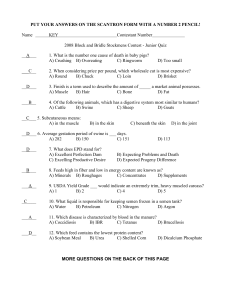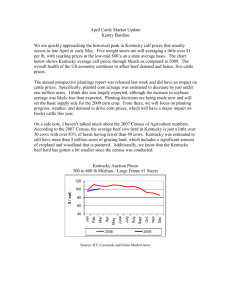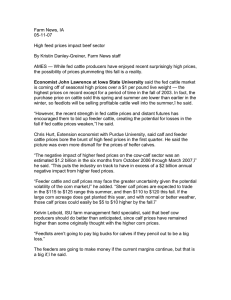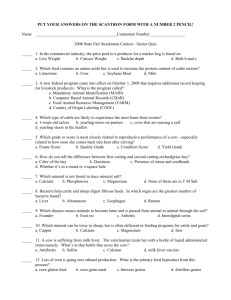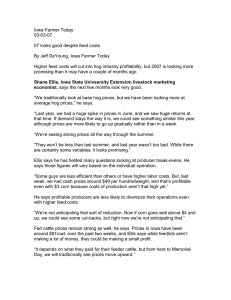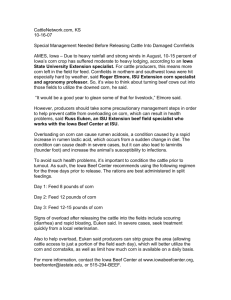AG-ECO NEWS Jose G. Peña Professor and Ext. Economist-Mgmt.
advertisement
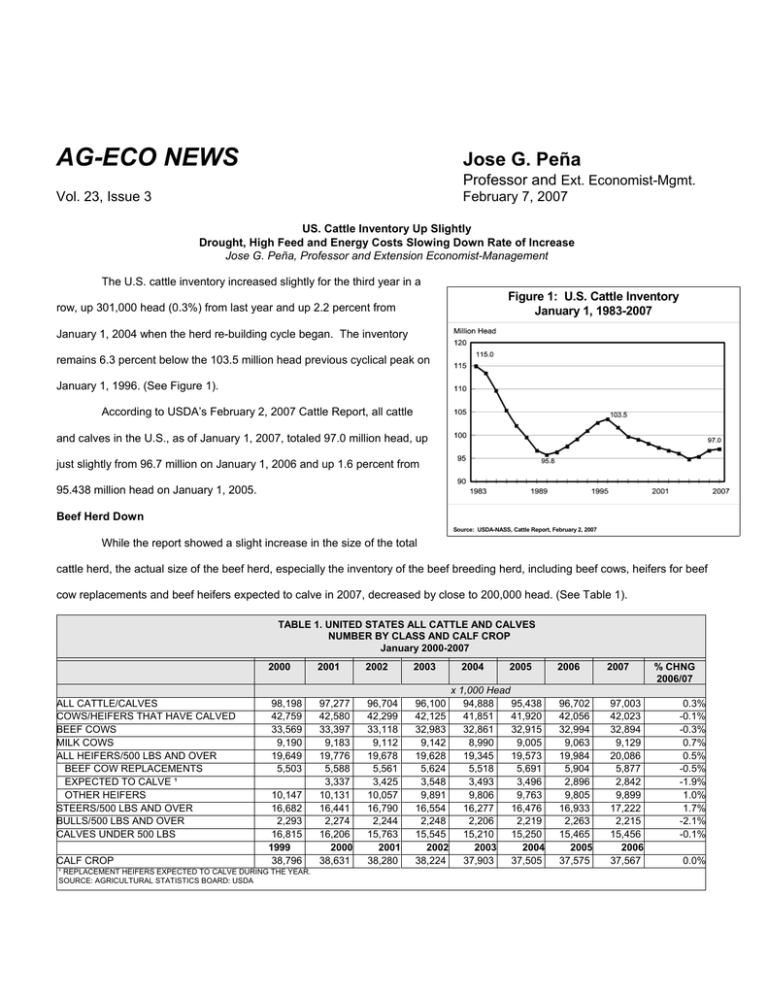
AG-ECO NEWS Jose G. Peña Professor and Ext. Economist-Mgmt. Vol. 23, Issue 3 February 7, 2007 US. Cattle Inventory Up Slightly Drought, High Feed and Energy Costs Slowing Down Rate of Increase Jose G. Peña, Professor and Extension Economist-Management The U.S. cattle inventory increased slightly for the third year in a Figure 1: U.S. Cattle Inventory January 1, 1983-2007 row, up 301,000 head (0.3%) from last year and up 2.2 percent from January 1, 2004 when the herd re-building cycle began. The inventory remains 6.3 percent below the 103.5 million head previous cyclical peak on January 1, 1996. (See Figure 1). According to USDA’s February 2, 2007 Cattle Report, all cattle and calves in the U.S., as of January 1, 2007, totaled 97.0 million head, up just slightly from 96.7 million on January 1, 2006 and up 1.6 percent from 95.438 million head on January 1, 2005. Beef Herd Down Source: USDA-NASS, Cattle Report, February 2, 2007 While the report showed a slight increase in the size of the total cattle herd, the actual size of the beef herd, especially the inventory of the beef breeding herd, including beef cows, heifers for beef cow replacements and beef heifers expected to calve in 2007, decreased by close to 200,000 head. (See Table 1). TABLE 1. UNITED STATES ALL CATTLE AND CALVES NUMBER BY CLASS AND CALF CROP January 2000-2007 2000 ALL CATTLE/CALVES COWS/HEIFERS THAT HAVE CALVED BEEF COWS MILK COWS ALL HEIFERS/500 LBS AND OVER BEEF COW REPLACEMENTS EXPECTED TO CALVE ¹ OTHER HEIFERS STEERS/500 LBS AND OVER BULLS/500 LBS AND OVER CALVES UNDER 500 LBS CALF CROP 98,198 42,759 33,569 9,190 19,649 5,503 10,147 16,682 2,293 16,815 1999 38,796 ¹ REPLACEMENT HEIFERS EXPECTED TO CALVE DURING THE YEAR. SOURCE: AGRICULTURAL STATISTICS BOARD: USDA 2001 2002 2003 97,277 42,580 33,397 9,183 19,776 5,588 3,337 10,131 16,441 2,274 16,206 2000 38,631 96,704 42,299 33,118 9,112 19,678 5,561 3,425 10,057 16,790 2,244 15,763 2001 38,280 96,100 42,125 32,983 9,142 19,628 5,624 3,548 9,891 16,554 2,248 15,545 2002 38,224 2004 2005 x 1,000 Head 94,888 95,438 41,851 41,920 32,861 32,915 8,990 9,005 19,345 19,573 5,518 5,691 3,493 3,496 9,806 9,763 16,277 16,476 2,206 2,219 15,210 15,250 2003 2004 37,903 37,505 2006 96,702 42,056 32,994 9,063 19,984 5,904 2,896 9,805 16,933 2,263 15,465 2005 37,575 2007 97,003 42,023 32,894 9,129 20,086 5,877 2,842 9,899 17,222 2,215 15,456 2006 37,567 % CHNG 2006/07 0.3% -0.1% -0.3% 0.7% 0.5% -0.5% -1.9% 1.0% 1.7% -2.1% -0.1% 0.0% In addition, the inventory of other heifers (heifers on pastures bound for feedlots) increased 94,000 head from an inventory 9.8 million head on January 1, 2006. This increase, plus the increase in the dairy herd and the large number of cattle on feed account for most of the total January 1, 2007 inventory increase. It appears that last year’s dry weather, high corn prices and high energy costs have had enough of a significant impact to stop the growth of the U.S. beef cattle herd. While moisture conditions have improved in major parts of the West and in the southern Plains, longer term weather forecasts from the National Weather Service suggest a return of drought conditions this summer. Grass, hay and feed grains could remain expensive this year. This area accounts for approximately 60 percent of the U.S. cattle herd. Figure 2: Selected Steer Prices Jan. ’05-Jan. ’07; 2005, 2006 Monthly; January 2007 Weekly Prices Prices Down 150 $/CWT After record high prices for most beef 140 130 cattle categories during winter ‘05-‘06, prices have weakened as the drought intensified and corn 120 110 100 prices increased. (See Figure 2). While calf prices have weakened from last winter’s record highs and 90 80 70 input costs, i.e., feed/energy costs, are up, prices 5 5 5 05 0 5 05 05 0 5 05 0 5 05 05 -06 -06 -06 -06 -06 -06 -06 -0 6 06 -06 0 6 0 6 07 07 0 7 0 7 07 0 7 l g p l g p - t v- c- 20 20 20 20 20 20 t v c n b r r y n n0 b0 r0 r y n Ja Fe M a Ap M a Ju Ju Au Se Oc No De Ja Fe M a Ap Ma Ju Ju Au Se Oc No De n.1, n.8, .15 , .16 , .22 , .29 , Ja Ja Ja n Ja nJa n Ja n for calves remain relatively attractive. This 400-500 LB 500-600 LB 700-800 LB 1100-1300 LB FED indicates that weather (cold/drought) and feed costs will be the key determinants of the future direction of the size of the U.S. cattle herd. 2007 prices based on January 2007 only Figure 3: Corn Utilization, In Alcohol for fuel Million bushels Ethanol 2500 2,150 The continuing surge in corn demand for 2000 ethanol production has and will continue to have a 1,600 significant widespread impact on U.S. agriculture, 1500 1,323 1,168 especially livestock agriculture as feed costs 996 1000 increase. This summer's boom in ethanol plant 2.15 billion bushels of corn, or about 20.4 percent of 458 396 429 481 566 628 706 05 04 03 02 01 06 20 20 20 20 20 00 99 97 96 95 94 93 92 98 Market Year 20 20 19 19 19 19 19 19 19 91 since 2002 and is now expected to consume about 426 526 0 19 Use for ethanol production has more than doubled 398 500 19 development was influenced by high energy costs. 533 this season's entire U.S. corn crop. (See Figure 3). Plan for High Feed Costs Keep in mind that increased demand for corn has resulted in sharply higher prices for corn, not a short crop. Demand driven corn prices will remain high unless corn production (or supplies of adequate substitutes or imports) increases significantly. While higher prices send a market signal for increased corn production, a crop of about 12 billion bushels of corn would be needed to make feed prices more economically manageable. Even with record corn yields in 2007, we would need to harvest about 4.4 million more acres of corn than were harvested this past season to come close to this level of production. This would mean planting about 82 million acres of corn to compensate for the historical harvested-to-planted ratio. With this past season’s average yields of 149.1 bu/ac., close to 89 million acres of corn would have to be planted. Where are these extra acres coming from? While we expect increased corn plantings, neither of these two scenarios appear very likely. As a result, cattle producers should plan to contend with higher feed costs as compared to the last few years of abundant supplies of corn and relatively inexpensive feed costs. Calf Crop Down The 2006 calf crop was estimated at 37.567 million head, down very slightly (0.02 percent) from 37.575 million calves born in 2005, but up 0.2 percent from a calf crop of 37.505 million head in 2004. Calves born during the first half of the year (spring 2007 feeder calf crop) were estimated at 27.4 million, up just slightly from 2005. Feedlots Full Meanwhile, feedlots appear behind in marketing, however, this past month’s winter storms have decreased productivity. According to USDA’s January 26, 2007 Cattle-on-Feed report, cattle and calves on feed for slaughter market in the United States for feedlots with capacity of 1,000 or more head totaled 12.0 million head on January 1, 2007, up one percent from January 1, 2006 and six percent above January 1, 2005. This is the highest January 1 inventory since the series began in 1996. Cattle placements in feedlots during December ‘06, however, totaled 1.71 million, nine percent below December ‘05 and seven percent below December ‘06.

